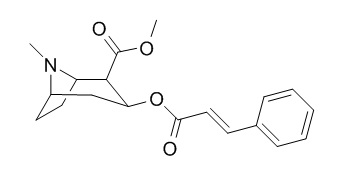Cinnamoylcocaine
Reference standards.
Inquire / Order:
manager@chemfaces.com
Technical Inquiries:
service@chemfaces.com
Tel:
+86-27-84237783
Fax:
+86-27-84254680
Address:
1 Building, No. 83, CheCheng Rd., Wuhan Economic and Technological Development Zone, Wuhan, Hubei 430056, PRC
Providing storage is as stated on the product vial and the vial is kept tightly sealed, the product can be stored for up to
24 months(2-8C).
Wherever possible, you should prepare and use solutions on the same day. However, if you need to make up stock solutions in advance, we recommend that you store the solution as aliquots in tightly sealed vials at -20C. Generally, these will be useable for up to two weeks. Before use, and prior to opening the vial we recommend that you allow your product to equilibrate to room temperature for at least 1 hour.
Need more advice on solubility, usage and handling? Please email to: service@chemfaces.com
The packaging of the product may have turned upside down during transportation, resulting in the natural compounds adhering to the neck or cap of the vial. take the vial out of its packaging and gently shake to let the compounds fall to the bottom of the vial. for liquid products, centrifuge at 200-500 RPM to gather the liquid at the bottom of the vial. try to avoid loss or contamination during handling.
Molecules.2023, 28(8):3490.
Korean. J. Pestic. Sci.2024, 28(3):241-248.
J.Korean Society of Grassland&Forage Science2023, 43(3):138-147.
Invest New Drugs.2017, 35(2):166-179
The Korea Journal of Herbology2020, 35(3):33-45.
J Korean Society of Food Science & Nutrition2021, 50(9): 962-970
Biomolecules.2024, 14(10):1257.
ACS Nano.2023, 17(11):9972-9986.
Auburn University2015, 1-58
PLoS One.2022, 17(4):e0267007.
Related and Featured Products
Int J Legal Med. 2015 Jan;129(1):69-84.
Possibilities for discrimination between chewing of coca leaves and abuse of cocaine by hair analysis including hygrine, cuscohygrine, cinnamoylcocaine and cocaine metabolite/cocaine ratios.[Pubmed:
25138383]
Contrary to the illegal use of any form of manufactured cocaine, chewing of coca leaves and drinking of coca tea are allowed and are very common and socially integrated in several South American countries. Because of this different legal state, an analytical method for discrimination between use of coca leaves and abuse of processed cocaine preparations is required.
METHODS AND RESULTS:
In this study, the applicability of hair analysis for this purpose was examined. Hair samples from 26 Argentinean coca chewers and 22 German cocaine users were analysed for cocaine (COC), norcocaine (NC), benzoylecgonine (BE), ecgonine methyl ester (EME), cocaethylene (CE), Cinnamoylcocaine (CIN), tropacocaine (TRO), cuscohygrine (CUS) and hygrine (HYG) by hydrophilic interaction liquid chromatography (HILIC) in combination with triplequad mass spectrometry (MS/MS) and hybrid quadrupole time-of-flight mass spectrometry (QTOF-MS). The following concentrations (range, median, ng/mg) were determined in hair of the coca chewers: COC 0.085-75.5, 17.0; NC 0.03-1.15, 0.12; BE 0.046-35.5, 6.1; EME 0.014-6.0, 0.66; CE 0.00-13.8, 0.38; CIN 0.005-16.8, 0.79; TRO 0.02-0.16, 0.023; CUS 0.026-26.7, 0.31. In lack of a reference substance, only qualitative data were obtained for HYG, and two metabolites of CUS were detected which were not found in hair of the cocaine users. For interpretation, the concentrations of the metabolites and of the coca alkaloids in relation to cocaine were statistically compared between coca chewers and cocaine users. By analysis of variance (ANOVA) significant differences were found for all analytes (α = 0.000 to 0.030) with the exception of TRO (α = 0.218). The ratios CUS/COC, CIN/COC and EME/COC appeared to be the most suitable criteria for discrimination between both groups with the means and medians 5-fold to 10-fold higher for coca chewers and a low overlap of the ranges between both groups. The same was qualitatively found for HYG. However, these criteria cannot exclude cocaine use in addition to coca chewing.
In this regard screening for typical cutting agents can be helpful and led to the detection of levamisole (21×), lidocaine (6×) and paracetamol (3×) in the 22 samples from German cocaine users, whereas no levamisole, lidocaine (3×) and paracetamol (1×) were found in hair from the Argentinean coca chewers.
CONCLUSIONS:
These criteria have to be confirmed for South American cocaine consumers including smokers of coca paste and may be different because of different composition of the drug and other use habits.
J Forensic Sci. 2007 Jul;52(4):860-6.
Four new illicit cocaine impurities from the oxidation of crude cocaine base: formation and characterization of the diastereomeric 2,3-dihydroxy-3-phenylpropionylecgonine methyl esters from cis- and trans-cinnamoylcocaine.[Pubmed:
17553089]
METHODS AND RESULTS:
Four diastereomeric diols formed from the oxidation of cis- and trans-Cinnamoylcocaine were characterized by nuclear magnetic resonance spectrometry, mass spectrometry, and synthesis. Oxidation of cis-Cinnamoylcocaine in neutral conditions yielded (2R,3R)-dihydroxy-3-phenylpropionylecgonine methyl ester and (2S,3S)-dihydroxy-3-phenylpropionylecgonine methyl ester, while trans-Cinnamoylcocaine produced (2R,3S)-dihydroxy-3-phenylpropionylecgonine methyl ester and (2S,3R)-dihydroxy-3-phenylpropionylecgonine methyl ester.
CONCLUSIONS:
The recent appearance of these new impurities suggests that some illicit cocaine processors have modified their oxidation procedures of crude cocaine base for transformation into illicit refined cocaine hydrochloride.



